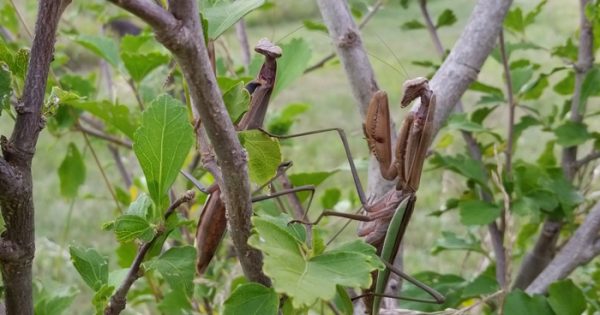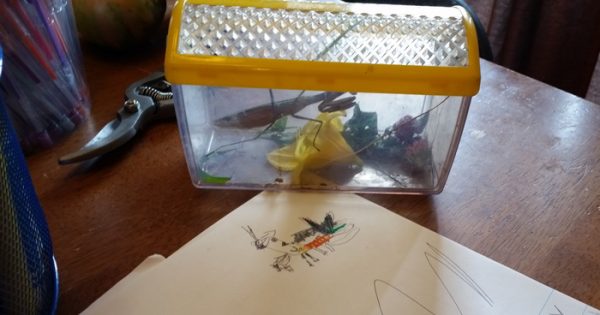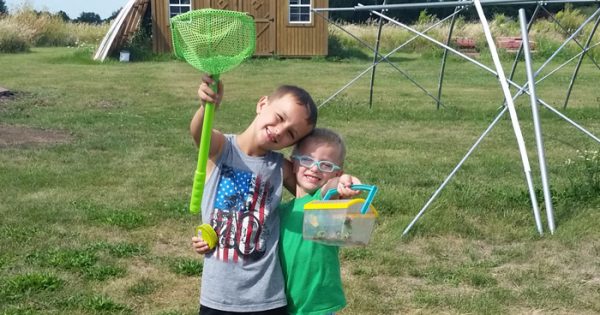What is it about bugs that fascinates kids?
From a very young age, my two boys squished, squashed, and saved bugs of all kinds. They are curious knowledge-seekers always asking me questions about their latest bug find. Here is a quick way to teach your kids about bugs:
The questions you’ll get:
What is this bug?
Why is it fuzzy?
Can it fly?
Use this natural curiosity to teach them to observe the world around them. Expand these lessons to broaden their young minds and feed their curiosity.

Look what I found!
Holding a kid’s interest can be challenging, especially when they are small and energetic. They constantly bounce from one subject to the next. But when they find something that interests them, they can obsess about it for days.
How to guide their interest
Similar to garden work, bugs are perfect tools to introduce science and biology to kids in a fun and engaging way. Grab an insect field guide or a laptop, and help kids identify the bug they found. They can learn so much, and you can tailor the information to their age.
- Count the legs and talk about how all true bugs have six legs.
- Identify the parts of the insect: head, abdomen, and thorax.
- Discuss how bees and butterflies help plants grow and fruit ripen.
- Ask them to sketch the bug they found or build it out of Legos®.
- Give them a journal to write down a few interesting facts about the bug.
My boys love to catch butterflies. We spent one afternoon finding, catching, and looking them up on the Internet, and in a few field guides. We learned about pollination, which led to a mini-lesson on how fruits and vegetables ripen. Naturally, we picked some fresh berries to snack on when we were done.

Do they bite?
Sometimes fascination can lead to fear if a kid touches a bug they shouldn’t or gets stung by a territorial bee. Teaching them to “look before they leap” is a great lead into a lesson about the social hierarchy of the insect world.
- Tell them why bees sting.
- Talk about the different kinds of bees in a hive.
- Did you know?
- Worker bees are all female
- Drones are all male and don’t have stingers
- The Queen rarely leaves the hive
Talking about the dangers of some bugs will make kids more cautious and less afraid of being stung or bitten. Knowing what to do when a bee comes near takes the fear out of being stung.
Friend or Foe?
Just like kids, every bug behaves differently. Teaching kids to observe bug behavior is another great learning tool.
Through careful observation, we learn whether the bug is a friend or foe in the garden.
It’s easy to see that bees and butterflies are beneficial. They fly and flutter from plant to plant leaving no sign of damage. We don’t feel the urge to squish them because we know they help.
But what about the bugs we don’t recognize?
It’s important for kids to learn to observe before interacting, so they don’t harm a helper.
Ask them to be bug hunters
They can search the ground under a pumpkin patch for squash bugs and watch as they swarm all over the stems and leaves. They can hunt for eggs by turning over and inspecting the backs of the leaves.
Talk to them about the harm that these bugs do to squash plants and ask them to think of ways to combat them naturally. Squishing squash bug eggs is highly satisfying and fun for all!
Some damage is easier to recognize
Japanese beetles swarm and cover leaves and their damage are almost instantly seen. Grab a bucket of soapy water and give the kids a mission to get as many beetles in the water as possible. The little buggers can’t swim.
Where do they come from?
Life cycles are another topic we can introduce through bugs. Turn the study of life cycles into a research project and science experiment.
- Ask the kids to find a caterpillar and put it in their bughouse.
- Make sure they take notes on the habitat, so they know what to feed them. It is usually the plant they were found on.
- Grab some field guides and do a Google search to identify the type of caterpillar.
- Teach them the difference between a chrysalis and a cocoon.
- Ask them to keep a journal of daily changes.
If you are lucky, the caterpillar will build a chrysalis or a cocoon, and a butterfly or moth will emerge after a few weeks. Raising butterflies is an amazing experience for the kids (and adults).
Life Lessons
By embracing the natural curiosity about bugs, we teach kids to work with nature rather than against it. We model “observing” before “interacting.” They learn that even the tiniest creature can help make a difference in the natural world.
I like bugs and squiggly things
Beetles with horns and moths with wings
Caterpillars and bumblebees
Dragonflies and ants and fleas
I love creepy crawlies
I love bugs!

Did you miss the article on Kids and Gardening? Check it out here!
How do you teach kids about the natural world? Tell us in the comments below.
Resources:
*Songs about Insects Bugs and Squiggly Things
Holmgren, Dave, Essence of Permaculture
Melissa Durbin is a Midwest homemaker, homesteader, and homeschooler. She has a passion for writing and loves to share all the triumphs and trials of gardening, raising chickens, and homeschooling two little boys.
In 2012, Melissa and her family moved from Metro Detroit to Illinois onto a 5-acre patch of flat land with poor soil and few trees. Since then, they’ve put in over a hundred fruit trees, built a small vineyard, planted a food hedge, and started a garden.
Melissa started blogging to chronicle the many adventures she’s had as a rookie homesteader. Her blog, https://apinchofhomestead.com/, is a mix of humorous anecdotes, true-life-inspired fiction and poetry, and lessons learned.
Melissa has a background in project management and writing. She worked in advertising for almost ten years before turning in the briefcase and starting her new life as a homesteader.







